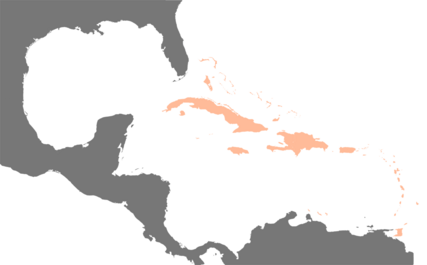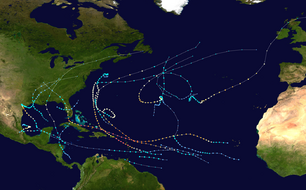Climate Change In The Caribbean
 From Handwiki
From Handwiki Anthropogenic climate change is caused by the rapid increase of greenhouse gases in the atmosphere principally from burning fossil fuels, converting forestland to pasture and monoculture cropland, with the greatest contributions happening in the period since the Industrial Revolution.

Climate change could pose disadvantageous risks to the islands in the Caribbean.[1] The environmental changes expected to affect the Caribbean are a rise in sea level, stronger hurricanes, longer dry seasons and shorter wet seasons.[1][2] As a result, climate change is expected to lead to changes in the economy, environment and population of the Caribbean.[3][4][5][6][7]
Geography
The Caribbean is composed of an archipelago of islands between North and South America. These islands are Antigua, Aruba, Barbados, Bonaire, the Cayman Islands, Cuba, Curacao, Dominica, Guadeloupe, Grenada, Hispaniola, Jamaica, Martinique, Montserrat, Puerto Rico, Saba, Saint Croix, Saint Eustatius, Saint John, Saint Kitts, Saint Lucia, Saint Thomas, Saint Vincent, Sint Maarten, the Bahamas, Tortola, and Trinidad and Tobago.The climate average annual temperature of the Caribbean is 81 °F.[8]
Environmental changes
Rise in sea level
Rising sea levels are expected to cause coastal erosion due to climate change. According to NASA, the sea level is expected to increase by 0.3–1 metre (1–4 ft) by 2050.[2] Rise in sea level could impact coastal communities of the Caribbean if they are less than 3 metres (10 ft) above the sea. In Latin America and the Caribbean, it is expected that 29 – 32 million people may be affected by the sea level rise because they live below this threshold. The Bahamas, Trinidad and Tobago are expected to be the most affected because at least 80% of the total land is below the sea level.[9][10] Coastal losses range between US$940 million to $1.2 billion in the 22 largest coastal cities in Latin America and the Caribbean.[6] Main sources of income, such as tourism, will also be affected because many of the main touristic attractions such as beaches and hotels are near the coast. In 2004, a study reported that 12 million tourists had visited the Caribbean. Damage to the beaches can also negatively impact sea turtles that nest in the Caribbeans. The islands are home to a few species of sea turtles, which are all facing endangerment due to the coastal erosion. Sea level rise can impact where sea turtles nest and their nesting behavior.[11]
Increased air and sea surface temperature

An increase in air and sea surface temperature is predicted to promote the development of stronger tropical cyclone (also known as hurricanes). Key factors that lead to the development of hurricanes are the warm temperatures of the air and sea surface. The higher temperatures increase the probability of the storm to become a hurricane. This provides the energy for the hurricane to intensify.[12][13]
In September 2017, the United States National Hurricane Center reported that the North Atlantic basin was highly active because four tropical storms formed and they all became hurricanes. They report a higher than average record on the number of tropical storms that developed into hurricanes this year.[14] Two of these four hurricanes, Irma and Maria, hit the islands in the Caribbean. Once at the Caribbean, both Irma and Maria became Category 5 hurricanes.[15] NASA reported that the temperature of the sea surface in the Caribbean when Irma became a hurricane was 30 °C (86 °F).[14] The required temperature for the development of a major storm is suggested to be higher than 27 °C (80 °F).[13]
_170923-H-NI589-0002_(37312143081).jpg)
Hurricanes of category 5 have wind speeds greater than 157 mph.[12] In addition to being strong, Hurricanes Irma and Maria also carried more rainfall than previous storms. The warmer the air temperature, the more water can be held by air leading to more precipitation. Multiple sources suggest that this increase in strengthening and precipitation in recent hurricanes is due to climate change.[16][15][17][18] Hurricane Irma and Maria had a total of 510 millimetres (20 in) of rainfall. In Cuba, Hurricane Irma sustained precipitation was at 270 millimetres (10.8 in) per hour. In Puerto Rico, Hurricane Maria had a sustained precipitation of 164 millimetres (6.44 in) per hour.[15] We are seeing repeated and prolonged droughts, an increase in the number of very hot days, intense rainfall events causing repeated localized flooding, and rising sea levels that are consuming the beautiful beaches on which tourism in the region depends.[19]
An increase in surface temperature has also been suggested to affect the coral reefs. In 2005 in the Caribbean, a rise in the sea surface temperature is thought to have caused widespread coral bleaching. In this study, they evaluate if this increase in sea surface temperature was due to natural climate variability or human activity. They concluded that it would be very unlikely that natural climate variability alone could account for this event. Their model suggests that this event would occur once every 1000 years if human activity is not taken into consideration in the model.[20] Coral reefs are a huge part of the Caribbean ocean and an important aspect to their ecosystem. Coral bleaching is an effect of the change in climate because of the rise in water temperature in the seawater. The coral is also being used as a "natural resource" for the natives to create cement and aggregate because they aren't provided with the same materials as are other countries.
Social and economic impacts
Multiple sources suggest that the Caribbean is in a particularly difficult position to address climate change.[3][6] The Caribbean's long history of colonialism for the extraction of goods, such as sugar, has left them dependent on colonial entities. This has created a disadvantage to the Caribbean as they lack the ability to compete with the current world economy and be self-sufficient. Centuries of colonialism has generated a feedback loop of the dependence of the Caribbean's economy on global powers.[3]
The damages expected from climate change will weaken the economy of the Caribbean as it will target some of the major sources of income, like tourism. It has been estimated that 25% to 35% of the Caribbean's economy relies on tourism.[9] Tourism could be significantly reduced if less tourists travel to the Caribbean because of an increase in the strength and likelihood of hurricanes in the next century. It is expected that hurricane costs are expected to range between US$350 to $550 million or about 11% to 17% of the current GDP for hurricane damages annually. They expect that the Bahamas, Haiti, and Jamaica are the islands that will suffer the most from climate change. In addition, they suggest that agricultural and rural areas are among the sectors that will be most affected by hurricanes in the Caribbean. They estimate that damages to these areas could cost about US$3 million per year by 2050 and US$12 – $15 million by 2100.[6]
Cultural Impacts
There are a variety of people that live on the Caribbean islands and they are heavily impacted on the effects of climate change. Culturally, the peoples of the Caribbean are a mix of Africa, Asian, European, and Indigenous peoples.[21] Tourism is an important aspect in the Caribbeans economy. Without it economies will collapse and residents will struggle more than they already are. The impact of climate change on tourism will lead to unknown results and many difficulties for the islands. The coastal region, where tourist reside on their trips, is nothing like the original residence for the natives.
See also
- Climate change (modern day)
- Climate change (general concept)
- Hurricane Irma
- Caribbean Sea
- Coral bleaching
References
- ↑ 1.0 1.1 Clinton L. Beckford, ed (2016). "1". Globalization, Agriculture and Food in the Caribbean. Palgrave Macmillan UK. doi:10.1057/978-1-137-53837-6. ISBN 978-1-137-53837-6.
- ↑ 2.0 2.1 Jackson, Randal. "Global Climate Change: Effects". https://climate.nasa.gov/effects.
- ↑ 3.0 3.1 3.2 Batiste, April Karen; Rhiney, Kevon (July 1, 2016). "Climate justice and the Caribbean: An introduction". Geoforum 73 (Supplement C): 17–21. doi:10.1016/j.geoforum.2016.04.008. ISSN 0016-7185.
- ↑ Ramón Bueno; Cornella Herzfeld; Elizabeth A. Stanton; Frank Ackerman (May 2008). The Caribbean and climate change: The costs of inaction. http://ase.tufts.edu/gdae/Pubs/rp/Caribbean-full-Eng.pdf.
- ↑ Winston Moore; Wayne Elliot; Troy Lorde (2017-04-01). "Climate change, Atlantic storm activity and the regional socio-economic impacts on the Caribbean". Environment, Development and Sustainability 19 (2): 707–726. doi:10.1007/s10668-016-9763-1. ISSN 1387-585X.
- ↑ 6.0 6.1 6.2 6.3 Reyer, Christopher (2017-08-01). "Climate change impacts in Latin America and the Caribbean and their implications for development". Regional Environmental Change 17 (6): 1601–1621. doi:10.1007/s10113-015-0854-6.
- ↑ Sealey-Huggins, Leon (2017-11-02). "'1.5°C to stay alive': climate change, imperialism and justice for the Caribbean". Third World Quarterly 38 (11): 2444–2463. doi:10.1080/01436597.2017.1368013.
- ↑ "Caribbean Weather: Annual Temperature & Rainfall - Current Results" (in en). https://www.currentresults.com/Weather/Caribbean/average-annual-temperature-rainfall.php.
- ↑ 9.0 9.1 Clement Lewsey; Gonzalo Cid; Edward Kruse (2004-09-01). "Assessing climate change impacts on coastal infrastructure in the Eastern Caribbean". Marine Policy 28 (5): 393–409. doi:10.1016/j.marpol.2003.10.016.
- ↑ Borja G. Reguero; Iñigo J. Losada; Pedro Díaz-Simal; Fernando J. Méndez; Michael W. Beck (2015). "Effects of Climate Change on Exposure to Coastal Flooding in Latin America and the Caribbean". PLOS ONE 10 (7): e0133409. doi:10.1371/journal.pone.0133409. PMID 26177285.
- ↑ Fish, Marianne R.; Côté, Isabelle M.; Gill, Jennifer A.; Jones, Andrew P.; Renshoff, Saskia; Watkinson, Andrew R. (2005). "Predicting the Impact of Sea-Level Rise on Caribbean Sea Turtle Nesting Habitat" (in en). Conservation Biology 19 (2): 482–491. doi:10.1111/j.1523-1739.2005.00146.x. ISSN 1523-1739.
- ↑ 12.0 12.1 Wall, Jennifer (2015-06-09). "What Are Hurricanes?". http://www.nasa.gov/audience/forstudents/5-8/features/nasa-knows/what-are-hurricanes-58.html.
- ↑ 13.0 13.1 Plumer, Brad (2016-10-06). "How do hurricanes form? A step-by-step guide". https://www.vox.com/science-and-health/2016/10/6/13191010/how-hurricanes-form-tropical-storms-guide.
- ↑ 14.0 14.1 "Monthly Atlantic Tropical Weather Summary". http://www.nhc.noaa.gov/text/MIATWSAT.shtml.
- ↑ 15.0 15.1 15.2 "One of the clearest signs of climate change in Hurricanes Maria, Irma, and Harvey was the rain". 2017-09-28. https://www.vox.com/energy-and-environment/2017/9/28/16362522/hurricane-maria-2017-irma-harvey-rain-flooding-climate-change.
- ↑ Taylor, Michael (2017-10-06). "Climate change in the Caribbean – learning lessons from Irma and Maria". The Guardian. https://www.theguardian.com/environment/2017/oct/06/climate-change-in-the-caribbean-learning-lessons-from-irma-and-maria.
- ↑ "Climate Change in the Caribbean Small Island States". http://www.iadb.org/en/office-of-evaluation-and-oversight/climate-change-in-the-caribbean-small-island-states,18283.html.
- ↑ Wallace-Wells, David. "Will Irma Finally Change the Way We Talk About Climate?". http://nymag.com/daily/intelligencer/2017/09/will-irma-finally-change-the-way-we-talk-about-climate.html. Retrieved 2017-09-09.
- ↑ Taylor, Michael. https://www.theguardian.com/environment/2017/oct/06/climate-change-in-the-caribbean-learning-lessons-from-irma-and-maria. "Climate change in the Caribbean- Learning lessons from Irma and Maria". 6 October 2017.
- ↑ Simon D. Donner; Thomas R. Knutson (2007-03-27). "Model-based assessment of the role of human-induced climate change in the 2005 Caribbean coral bleaching event". Proceedings of the National Academy of Sciences 104 (13): 5483–5488. doi:10.1073/pnas.0610122104. PMID 17360373.
- ↑ Coastal Education & Research. https://www.jstor.org/stable/25736087?seq=5#metadata_info_tab_contents. "Climate change impacts on the Caribbean coastal areas and tourism". ISSUE NO. 24. pp. 49-69.
Added Links:
- https://www.jstor.org/stable/41917607?seq=1#metadata_info_tab_contents CLIMATE CHANGE AND THE CARIBBEAN: REVIEW AND RESPONSE
- https://agupubs.onlinelibrary.wiley.com/doi/abs/10.1029/2010EO160002 Volcanic Vents Found in Deep Caribbean Waters
Further reading
- U.S. Global Change Research Program (2018). Impacts, Risks, and Adaptation in the United States: Fourth National Climate Assessment, Volume II (Report). Washington, DC, USA: U.S. Global Change Research Program. p. 809–871. doi:10.7930/NCA4.2018.CH20.
Categories: [Climate change]
↧ Download as ZWI file | Last modified: 03/12/2024 22:49:22 | 20 views
☰ Source: https://handwiki.org/wiki/Earth:Climate_change_in_the_Caribbean | License: CC BY-SA 3.0

 KSF
KSF